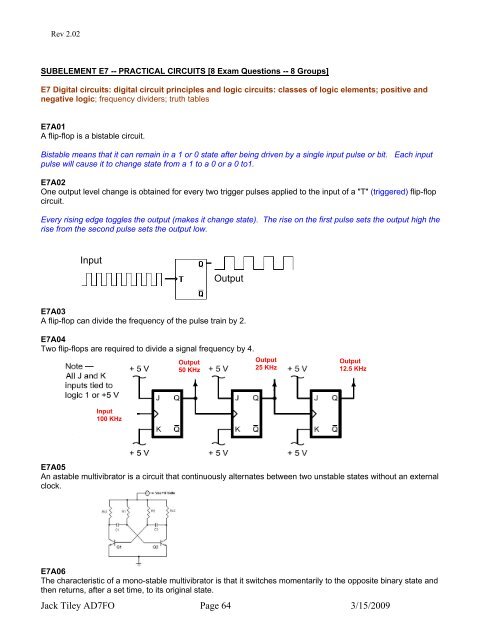You also want an ePaper? Increase the reach of your titles
YUMPU automatically turns print PDFs into web optimized ePapers that Google loves.
Rev 2.02<br />
SUBELEMENT E7 -- PRACTICAL CIRCUITS [8 Exam Questions -- 8 Groups]<br />
E7 Digital circuits: digital circuit principles and logic circuits: classes of logic elements; positive and<br />
negative logic; frequency dividers; truth tables<br />
E7A01<br />
A flip-flop is a bistable circuit.<br />
Bistable means that it can remain in a 1 or 0 state after being driven by a single input pulse or bit. Each input<br />
pulse will cause it to change state from a 1 to a 0 or a 0 to1.<br />
E7A02<br />
One output level change is obtained for every two trigger pulses applied to the input of a "T" (triggered) flip-flop<br />
circuit.<br />
Every rising edge toggles the output (makes it change state). The rise on the first pulse sets the output high the<br />
rise from the second pulse sets the output low.<br />
Input<br />
E7A03<br />
A flip-flop can divide the frequency of the pulse train by 2.<br />
E7A04<br />
Two flip-flops are required to divide a signal frequency by 4.<br />
Input<br />
100 KHz<br />
Output<br />
50 KHz<br />
Output<br />
Output<br />
25 KHz<br />
Output<br />
12.5 KHz<br />
E7A05<br />
An astable multivibrator is a circuit that continuously alternates between two unstable states without an external<br />
clock.<br />
E7A06<br />
The characteristic of a mono-stable multivibrator is that it switches momentarily to the opposite binary state and<br />
then returns, after a set time, to its original state.<br />
Jack Tiley <strong>AD7FO</strong> Page 64 3/15/2009


